Abstract
A general procedure for the isolation of functionally intact phycobilisomes was devised, based on modifications of previously used procedures. It has been successful with numerous species of red and blue-green algae (Anabaena variabilis, Anacystis nidulans, Agmenellum quadruplicatum, Fremyella diplosiphon, Glaucosphaera vacuolata, Griffithsia pacifica, Nemalion multifidum, Nostoc sp., Phormidium persicinum, Porphyridium cruentum, P. sordidum, P. aerugineum, Rhodosorus marinus). Isolation was carried out in 0.75 molar K-phosphate (pH 6.8 to 7.0) at 20 to 23 C on sucrose step gradients. Lower temperature (4 to 10 C) was usually unfavorable resulting in uncoupling of energy transfer and partial dissociation of the phycobilisomes, sometimes with complete loss of allophycocyanin. Intact phycobilisomes were characterized by fluorescence emission peaks of 670 to 675 nanometers at room temperature, and 678 to 685 nanometers at liquid nitrogen temperature. Uncoupling and subsequent dissociation of phycobilisomes, in lowered ionic conditions, varied with the species and the degree of dissociation but occurred preferentially between phycocyanin and allophycocyanin, or between phycocyanin and phycoerythrin.
Full text
PDF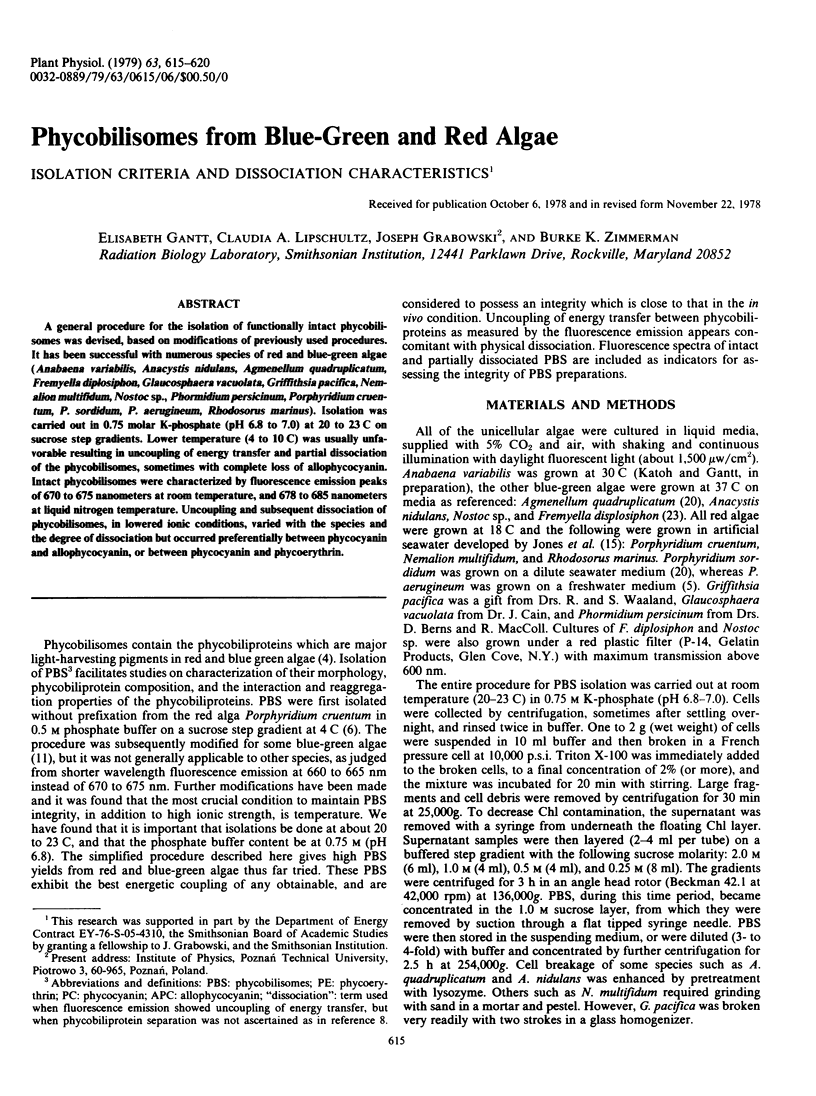
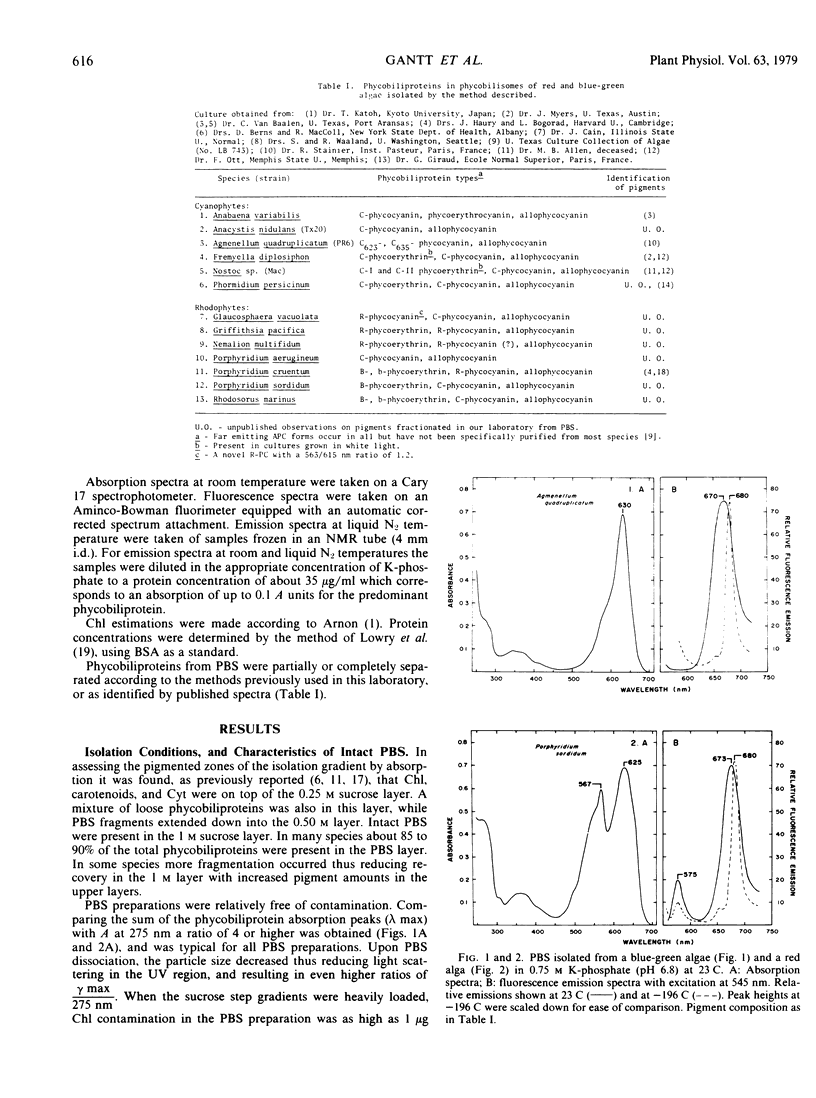
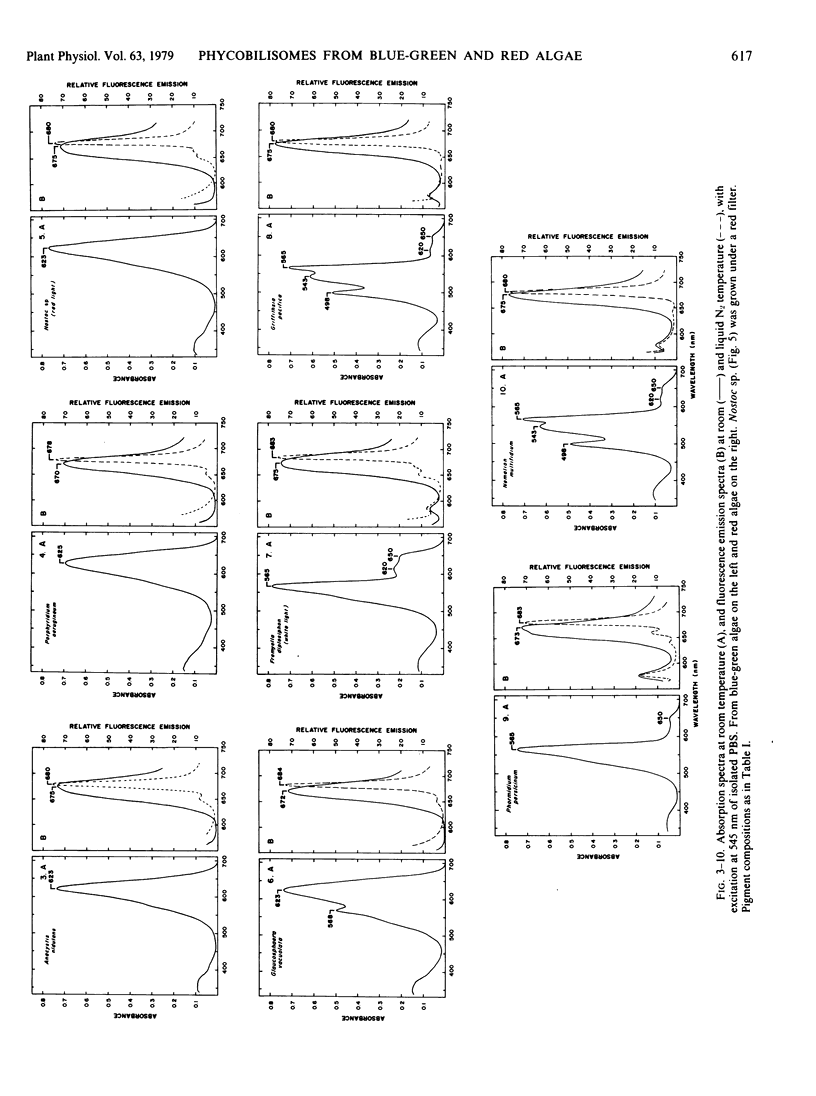
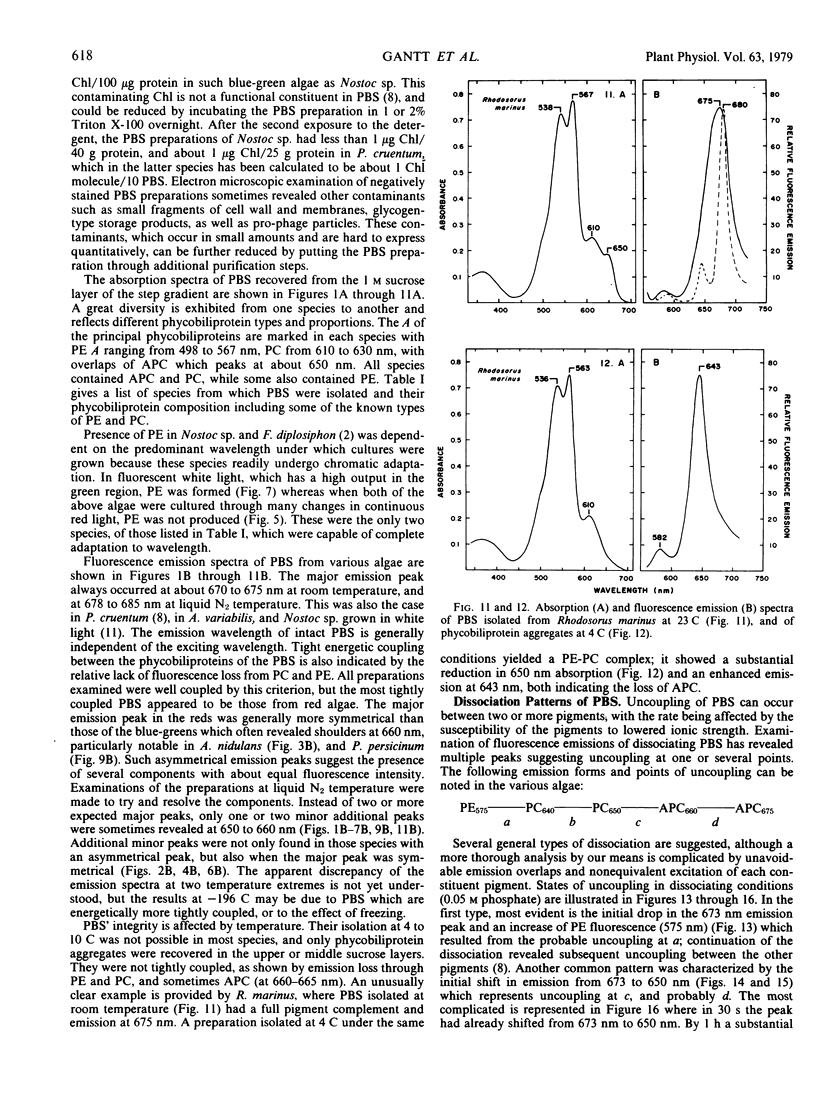
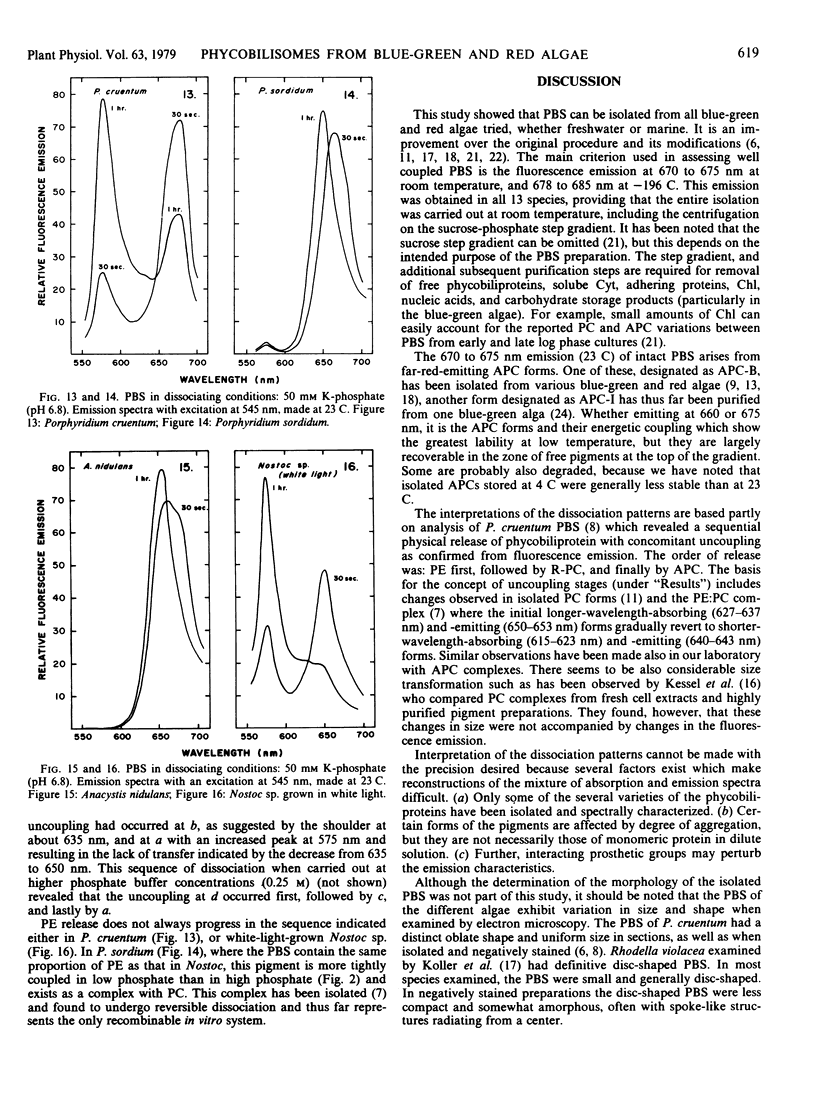
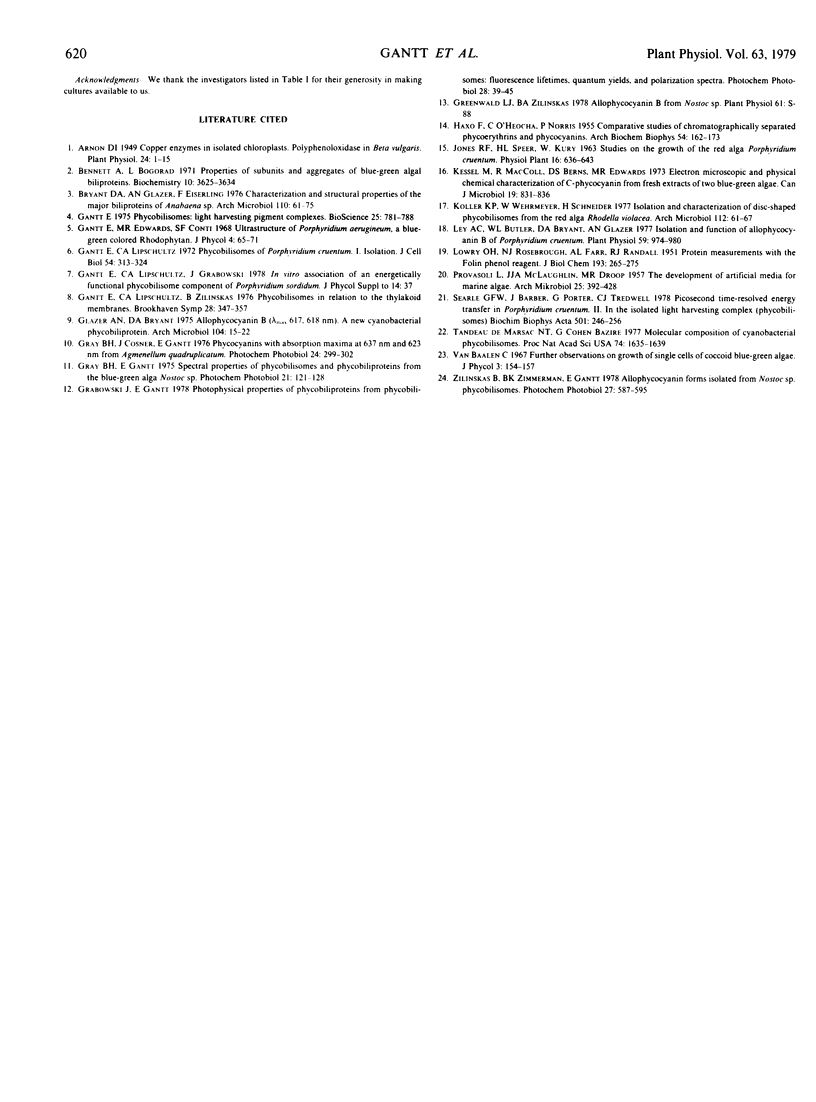
Selected References
These references are in PubMed. This may not be the complete list of references from this article.
- Arnon D. I. COPPER ENZYMES IN ISOLATED CHLOROPLASTS. POLYPHENOLOXIDASE IN BETA VULGARIS. Plant Physiol. 1949 Jan;24(1):1–15. doi: 10.1104/pp.24.1.1. [DOI] [PMC free article] [PubMed] [Google Scholar]
- Bennett A., Bogorad L. Properties of subunits and aggregates of blue-green algal biliproteins. Biochemistry. 1971 Sep 14;10(19):3625–3634. doi: 10.1021/bi00795a022. [DOI] [PubMed] [Google Scholar]
- Bryant D. A., Glazer A. N., Eiserling F. A. Characterization and structural properties of the major biliproteins of Anabaena sp. Arch Microbiol. 1976 Oct 11;110(1):61–75. doi: 10.1007/BF00416970. [DOI] [PubMed] [Google Scholar]
- Gantt E., Lipschultz C. A. Phycobilisomes of Porphyridium cruentum. I. Isolation. J Cell Biol. 1972 Aug;54(2):313–324. doi: 10.1083/jcb.54.2.313. [DOI] [PMC free article] [PubMed] [Google Scholar]
- Gantt E., Lipschultz C. A., Zilinskas B. A. Phycobilisomes in relation to the Thylakoid membranes. Brookhaven Symp Biol. 1976 Jun 7;(28):347–357. [PubMed] [Google Scholar]
- Gray B. H., Gantt E. Spectral properties of phycobilisomes and phycobiliproteins from the blue-green alga-nostoc sp. Photochem Photobiol. 1975 Feb;21(2):121–128. doi: 10.1111/j.1751-1097.1975.tb06638.x. [DOI] [PubMed] [Google Scholar]
- HAXO F., O'HEOCHA C., NORRIS P. Comparative studies of chromatographically separated phycoerythrins and phycocyanins. Arch Biochem Biophys. 1955 Jan;54(1):162–173. doi: 10.1016/0003-9861(55)90019-9. [DOI] [PubMed] [Google Scholar]
- Kessel M., MacColl R., Berns D. S., Edwards M. R. Electron microscope and physical chemical characterization of C-phycocyanin from fresh extracts of two blue-green algae. Can J Microbiol. 1973 Jul;19(7):831–836. doi: 10.1139/m73-133. [DOI] [PubMed] [Google Scholar]
- Koller K. P., Wehrmeyer W., Schneider H. Isolation and characterization of disc-shaped phycobilisomes from the red alga Rhodella violacea. Arch Microbiol. 1977 Feb 4;112(1):61–67. doi: 10.1007/BF00446655. [DOI] [PubMed] [Google Scholar]
- LOWRY O. H., ROSEBROUGH N. J., FARR A. L., RANDALL R. J. Protein measurement with the Folin phenol reagent. J Biol Chem. 1951 Nov;193(1):265–275. [PubMed] [Google Scholar]
- Ley A. C., Butler W. L. Isolation and Function of Allophycocyanin B of Porphyridium cruentum. Plant Physiol. 1977 May;59(5):974–980. doi: 10.1104/pp.59.5.974. [DOI] [PMC free article] [PubMed] [Google Scholar]
- PROVASOLI L., MCLAUGHLIN J. J., DROOP M. R. The development of artificial media for marine algae. Arch Mikrobiol. 1957;25(4):392–428. doi: 10.1007/BF00446694. [DOI] [PubMed] [Google Scholar]
- Searle G. F., Barber J., Porter G., Tredwell C. J. Picosecond time-resolved energy transfer in Porphyridium cruentum. Part II. In the isolated light harvesting complex (phycobilisomes). Biochim Biophys Acta. 1978 Feb 9;501(2):246–256. doi: 10.1016/0005-2728(78)90030-0. [DOI] [PubMed] [Google Scholar]
- de Marsac N. T., Cohen-bazire G. Molecular composition of cyanobacterial phycobilisomes. Proc Natl Acad Sci U S A. 1977 Apr;74(4):1635–1639. doi: 10.1073/pnas.74.4.1635. [DOI] [PMC free article] [PubMed] [Google Scholar]


